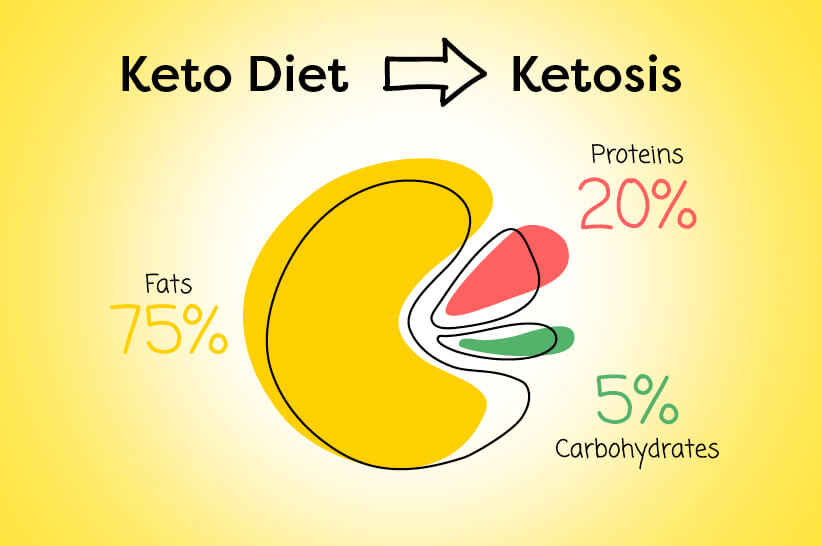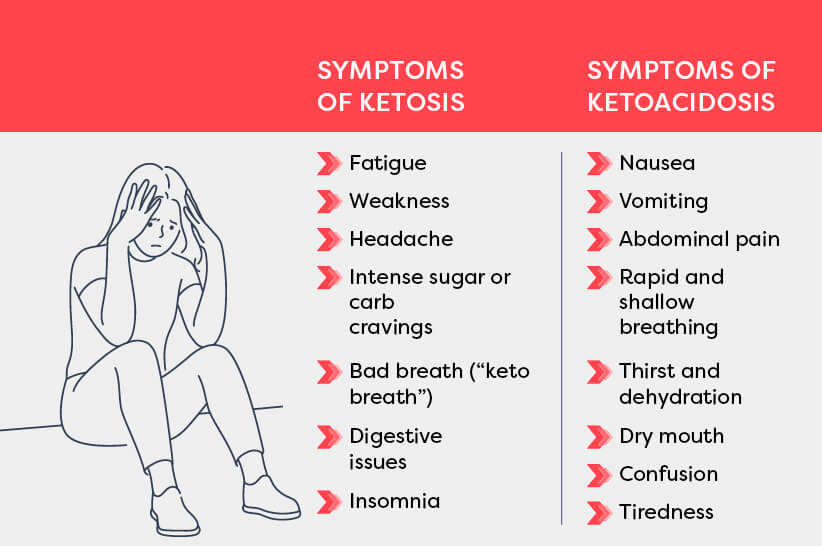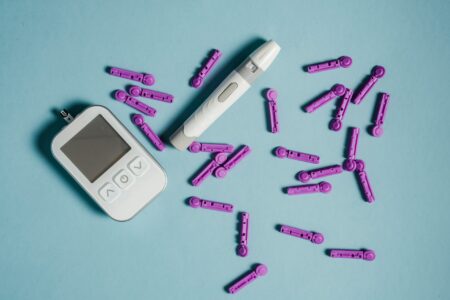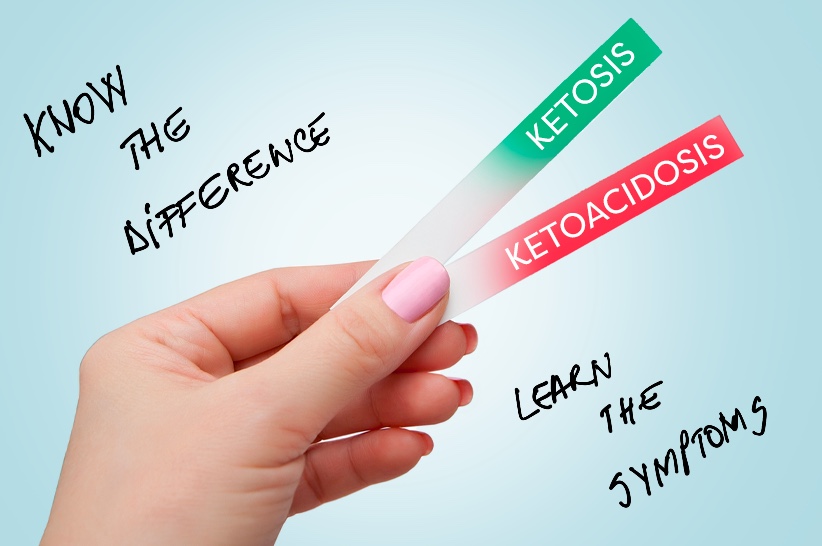Ketosis and ketoacidosis may sound the same, but in reality, they are two different things. Find out more in this guide.
Confused between the two? Don’t be. The first thing you need to know is this:
Nutritional ketosis is a natural state in the body and can be beneficial for many people. Meanwhile, ketoacidosis is an abnormal, life-threatening condition. It often happens as a complication of type 1 diabetes 1.
What Is Ketosis?
Ketosis results from following a low-carb, high-fat diet – commonly known as the keto diet.
Because when you eat fewer carbs, your glycogen stores get depleted as well. Once depleted, your body burns its own fat which then generates ketones. At this point, ketones act as your fuel instead of glucose.
You need to reduce your carbs to 20-50 grams daily to induce ketosis 2. You will know that you’ve entered this state by checking your ketone levels. Also, you will experience certain symptoms that indicate ketosis.
It is normal to have ketones ranging from 0.5 to 3.0 mM in healthy individuals 3. Some people enter nutritional ketosis within a few days of restricting carbs. For others, it can take weeks.

For those who don’t know, ketosis has been used traditionally in the 1920s as a treatment for epilepsy. Research shows that ketone bodies have anticonvulsant effects 4.
Today, many people use the keto diet for its benefits on weight loss, blood glucose management, and physical performance.
What Is Ketoacidosis?
Ketoacidosis is different. As mentioned earlier, it is an abnormal condition that often happens as a complication in type 1 diabetes. That is why it is also called diabetic ketoacidosis (DKA). It’s rare in type 2 diabetes.
What causes ketoacidosis? It happens when the body produces too many ketones that build up in the blood.
A person does not have enough insulin, and so cells cannot use glucose for energy. Since glucose is not available, the body taps into its fat stores. Ketones are produced.
During ketoacidosis, ketone concentrations go over 3 mM. But someone who’s already diagnosed with diabetes should watch their ketones often. A reading of 1.6 to 2.9 mM means that they are at risk for DKA. They should contact their health care provider immediately 5.
Ketosis vs. Ketoacidosis
To help you get a clearer picture, in this section we’re going to compare the difference between ketosis and ketoacidosis. That way, you will know what to expect.
Symptoms
Ketosis is beneficial for the body. But before you experience the full benefits of keto, your body goes through some negative symptoms. These symptoms can last for a few days to a month. Keep in mind that this is your body adjusting to this new way of eating.
Below are the common symptoms to expect:
- Fatigue
- Weakness
- Headache
- Intense sugar or carb cravings
- Bad breath (“keto breath”)
- Digestive issues
- Insomnia

People with type 1 diabetes can develop DKA as a complication. Patients with ketoacidosis usually present with the following symptoms:
- Nausea
- Vomiting
- Abdominal pain
- Rapid and shallow breathing
- Thirst and dehydration
- Dry mouth
- Confusion
- Tiredness
In severe cases, a person will have low blood pressure. Without immediate treatment, DKA can lead to coma or death 6.
Risk factors
What can trigger ketosis?
Ketosis can only take place as a result of reducing your carbohydrates or fasting. Both circumstances force your body to use up its stored glycogen. After that, it breaks down fat to produce ketones.
What can lead to ketoacidosis?
As mentioned earlier in this article, type 1 diabetes is the most common cause of ketoacidosis. In 30 to 50 percent of cases, infection triggers DKA. These include urinary tract infection (UTI) and pneumonia. Another trigger is when a patient doesn’t comply with their insulin therapy. 7.
Lisa Richards, CNC, says that while diabetes diagnoses are more at risk for DKA, other risk factors include drug misuse or extremely low calorie or carb intake.
Ketone levels
What level of ketones indicates ketosis? Normal ketosis levels should range between 0.5 to 3.0 mM. Keep in mind that ketones are very sensitive to the foods you eat. Eating something that contains a moderate amount of carbs can easily throw you out of ketosis and decrease your ketone levels 8.
Do you have diabetes and follow a ketogenic diet with the guidance of a health professional? If that’s the case, know that you will not be at risk for ketoacidosis as long as you maintain normal blood glucose levels.

Ketoacidosis is diagnosed with abnormal ketone concentrations. The range is usually above 3 mM – higher than typical ketosis levels.
Ketone levels are best measured using a blood ketone meter. This measures the amount of beta-hydroxybutyrate in the blood. (Note: Beta-hydroxybutyrate is the major ketone body produced in ketosis.)
Using ketone urine strips is also helpful, although it isn’t as accurate.
Treatment
Diabetic ketoacidosis may be life-threatening, but it is treatable. The first step is being able to properly identify it. Treatment usually includes the following 9:
- Administering insulin
- Replacing electrolytes
The patient will be closely monitored until their ketone concentrations return to normal.
Prevention
The good news is, DKA is preventable. The bottom line is, you need to be attentive to your health regularly.
Here are some things you can do 10, 11:
- Monitor your ketone levels at home, especially when you have high blood glucose readings.
- Check your blood glucose levels. If they are above-normal, let your health care provider know about it.
- Know the warning signs of ketoacidosis. Contact your doctor immediately. Do the same when you feel ill.
- Follow your prescribed insulin regimen.
- Protect yourself from infection or intense physical stress.
If you are away from home, make sure that you wear a medical identification bracelet. This will ensure that you get prompt medical help from strangers in case something happens.
Can Ketosis Lead to Ketoacidosis?
Although ketosis and ketoacidosis are not the same, abnormal ketone levels can trigger ketoacidosis.
“Yes, ketosis that allows ketones to reach a high level in the blood can lead to ketoacidosis. The blood becomes overly acidic and organs begin to function inadequately,” says Lisa Richards.
With what you know now, you might ask at the end of the day – can those at risk for diabetes or already have type 2 diabetes safely enter nutritional ketosis?
The answer to that is yes. In fact, following a low-carb, high-fat diet keeps diabetes under control. As long as you do it under the supervision of a health professional, you should be fine.
Takeaways
- Nutritional ketosis is beneficial while DKA is an abnormal condition.
- If you are a diabetic and follow a keto diet without properly monitoring your ketones and health, or following your doctor’s orders, your ketones could rise to abnormal levels. This triggers ketoacidosis.
- The ketogenic diet is safe and good for healthy people and those at risk for certain diseases. It helps manage some conditions too. At the end of the day, it is best to discuss with a doctor before attempting a new diet or lifestyle.










![Juicing for Weight Loss: Everything You Need to Know [Plus Recipes]](/wp-content/uploads/2019/08/Juicing-for-Weight-featured-image.jpg)








